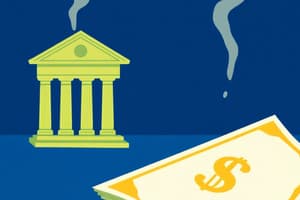Podcast
Questions and Answers
What percentage of member states voted to leave the EU?
What percentage of member states voted to leave the EU?
- 60%
- 51.9% (correct)
- 48.1%
- 70%
Why did the UK want to leave the EU according to the content?
Why did the UK want to leave the EU according to the content?
- EU has too many rules and regulations
- EU allows too many immigrants
- EU threats British Sovereignty
- All of the above (correct)
What is the Banker of the Government designated as?
What is the Banker of the Government designated as?
- Bangko Sentral (correct)
- International Monetary Fund
- Central Bank of the Philippines
- European Central Bank
What international organization is the Bangko Sentral represented in?
What international organization is the Bangko Sentral represented in?
What is one of the reasons the UK wanted to leave the EU?
What is one of the reasons the UK wanted to leave the EU?
What chapter is related to the functions of the Bangko Sentral?
What chapter is related to the functions of the Bangko Sentral?
What was drafted by Secretary of Finance Manuel Roxas in 1939?
What was drafted by Secretary of Finance Manuel Roxas in 1939?
What is the primary motive of the Bangko Sentral ng Pilipinas (BSP)?
What is the primary motive of the Bangko Sentral ng Pilipinas (BSP)?
What is a key characteristic of the Bangko Sentral ng Pilipinas (BSP) as a central bank?
What is a key characteristic of the Bangko Sentral ng Pilipinas (BSP) as a central bank?
What is one of the key functions of the Bangko Sentral ng Pilipinas (BSP) as a bank of issue?
What is one of the key functions of the Bangko Sentral ng Pilipinas (BSP) as a bank of issue?
What is the main reason for the Bangko Sentral ng Pilipinas (BSP) to issue notes and coins?
What is the main reason for the Bangko Sentral ng Pilipinas (BSP) to issue notes and coins?
What is the role of the Bangko Sentral ng Pilipinas (BSP) as the government's banker?
What is the role of the Bangko Sentral ng Pilipinas (BSP) as the government's banker?
What is the Financial Supervision Sector (FSS) responsible for?
What is the Financial Supervision Sector (FSS) responsible for?
What is the Monetary Economics Sector (MES) responsible for?
What is the Monetary Economics Sector (MES) responsible for?
What is the primary function of centralized reserves in mitigating bank runs?
What is the primary function of centralized reserves in mitigating bank runs?
What is the role of centralized reserves during currency crises?
What is the role of centralized reserves during currency crises?
What is the role of centralized reserves during liquidity shortages?
What is the role of centralized reserves during liquidity shortages?
What is the role of the Bangko Sentral ng Pilipinas (BSP) in reserve management?
What is the role of the Bangko Sentral ng Pilipinas (BSP) in reserve management?
What is the purpose of maturity reserves?
What is the purpose of maturity reserves?
What is the purpose of capital reserves?
What is the purpose of capital reserves?
What is the purpose of demand deposits?
What is the purpose of demand deposits?
What is the purpose of compensating balances?
What is the purpose of compensating balances?
When was the Bank of Japan established?
When was the Bank of Japan established?
What is one of the goals of monetary policy?
What is one of the goals of monetary policy?
What happened in 1942?
What happened in 1942?
What is a feature of monetary policy?
What is a feature of monetary policy?
What happened in the 1980s in Japan?
What happened in the 1980s in Japan?
What is another goal of monetary policy?
What is another goal of monetary policy?
What happened in 1897?
What happened in 1897?
When did business operation of the Bank of Japan begin?
When did business operation of the Bank of Japan begin?
When was the Bank of Japan Act of 1997 promulgated?
When was the Bank of Japan Act of 1997 promulgated?
What is the primary function of the Bank of Japan?
What is the primary function of the Bank of Japan?
What is the role of the Monetary Board?
What is the role of the Monetary Board?
What is one of the key functions of the Bank of Japan?
What is one of the key functions of the Bank of Japan?
What is the role of the Bank of Japan in payment settlement systems?
What is the role of the Bank of Japan in payment settlement systems?
What is the role of the Bank of Japan in market operations?
What is the role of the Bank of Japan in market operations?
What is one of the key functions of the Bank of Japan?
What is one of the key functions of the Bank of Japan?
Who is part of the Monetary Board?
Who is part of the Monetary Board?
Flashcards are hidden until you start studying
Study Notes
Central Banks
- 1939: A bill establishing a central bank was drafted by Secretary of Finance Manuel Roxas and approved by the Philippine Legislature.
Characteristics of BSP as a Central Bank
- Profit motive is only secondary
- Operations are controlled by government laws
- Does not deal directly with the public
Functions of the BSP
- It is a bank of issue, with the sole power to issue notes and coins for uniformity, government supervision over the money supply, and as a source of income
- It is the government's banker, responsible for managing all account transactions of the government
- It is an agent of the government, with fixed deposits, and responsible for liquidity reserves and capital reserves
The New Organizational Structure of the BSP
- Financial Supervision Sector (FSS) – responsible for the regulation of banks and other BSP-supervised financial institutions
- Monetary Economics Sector (MES) – responsible for the regulation of banks and other BSP-supervised financial institutions
Role of Centralized Reserves in Mitigating Risks
- Bank Runs - Centralized reserves provide a source of liquidity for banks facing sudden withdrawal demands
- Currency Crises - Centralized reserves help defend against currency crises by providing the central bank with the necessary resources to intervene in the foreign exchange market
- Liquidity Shortages - Centralized reserves act as a backstop to ensure the smooth functioning of interbank lending and payment systems
Role of BSP in Securing and Facilitating Reserves
- Reserve Management - managing the Philippines' foreign exchange reserves, ensuring their safety and liquidity
- Managing liquidity reserves, capital reserves, and fixed deposits
Bank of Japan
- Established in 1882, with the BOJ Act of 1882 promulgated
- 1897: Japan adopts the gold standard to stabilize the yen
- 1910s to 1942: World War Era
- 1942: Bank of Japan Act of 1942 is promulgated, and the Bank was reorganized
- Post-War, Economic Construction & Growth (1949 to 1950s)
- Bubble Economy Era (1980s to 1990s)
- Post-Bubble Era (1997 to 1998)
Functions of the Bank of Japan
-
- Monetary Policy
- To maintain price stability
-
- Currency Issuance
- Issues Japanese yen
-
- Financial System Stability
- Monitors and maintains stability of financial system
-
- Payment Settlement Systems
-
- Market Operations
- Controls money supply & interest rate
-
- Financial Services for the Government
-
- International Finance
-
- Ensures Smooth Settlement of Funds
Studying That Suits You
Use AI to generate personalized quizzes and flashcards to suit your learning preferences.




